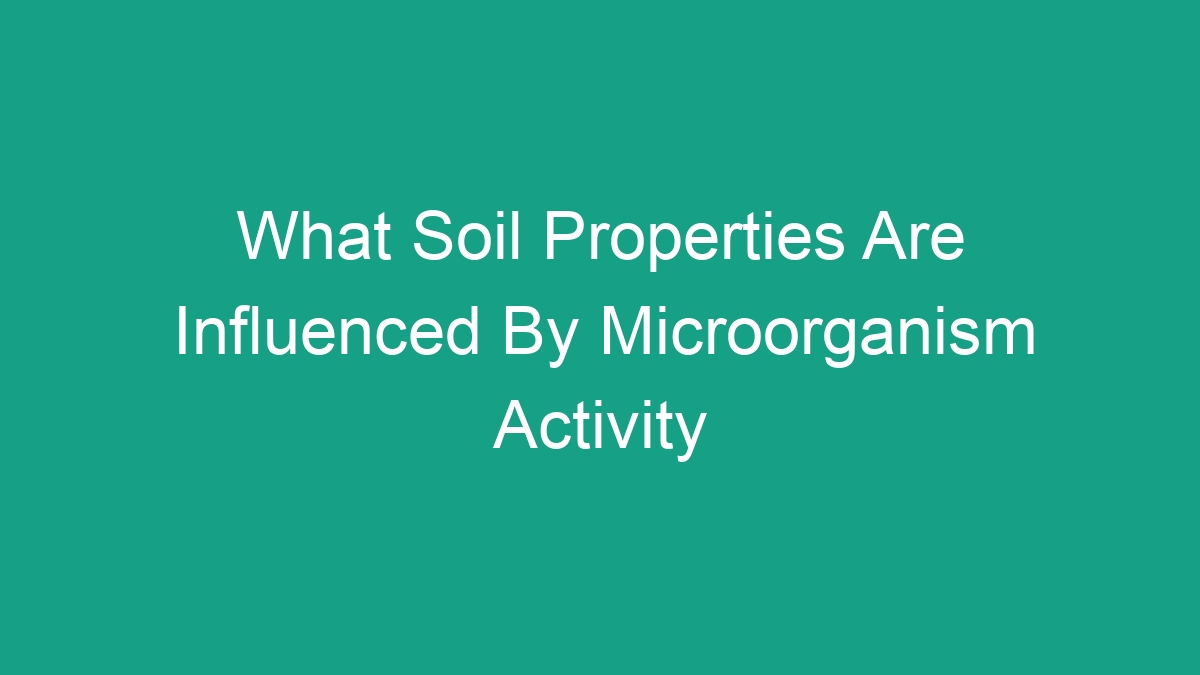
Soil is a complex and dynamic system that plays a vital role in ecosystem function and food production. It provides the physical support, water, and nutrients necessary for plant growth. One crucial aspect of soil health and fertility is the activity of microorganisms. They are a key component of soil ecosystems and play a critical role in shaping soil properties through their metabolic processes. In this article, we will explore what soil properties are influenced by microorganism activity and why understanding this influence is essential for sustainable land management and agricultural practices.
Soil Structure
One of the most significant impacts of microorganism activity on soil properties is its influence on soil structure. Soil structure refers to the way in which soil particles are arranged and aggregated. Microorganisms, particularly certain types of fungi and bacteria, produce substances like glomalin and extracellular polysaccharides, which act as binding agents and contribute to soil aggregation. This helps to create pore spaces in the soil, improving water infiltration and retention, as well as enhancing root penetration and aeration. Additionally, microorganisms can influence soil structure by creating channels and pores through their movement and feeding activities. These alterations to soil structure have a direct impact on its physical properties, such as porosity, water-holding capacity, and resistance to erosion.
Nutrient Cycling
Microorganisms play a crucial role in the cycling and availability of nutrients in the soil. They decompose organic matter and release essential nutrients, such as nitrogen, phosphorus, and sulfur, from organic compounds, making them available for plant uptake. This process, known as mineralization, is essential for sustaining soil fertility and supporting plant growth. Furthermore, through their symbiotic relationships with plants, certain microorganisms, such as mycorrhizal fungi and nitrogen-fixing bacteria, can directly enhance nutrient uptake by plants. The activities of these microorganisms help to maintain a balanced and efficient nutrient cycle within the soil, influencing its chemical properties and overall fertility.
Soil pH
The pH of soil, which measures its acidity or alkalinity, is a critical soil property that directly affects nutrient availability and microbial activity. Microorganisms can directly influence soil pH through their metabolic processes. For example, the production of organic acids by certain bacteria and fungi can lead to the acidification of soil, while others may alkalize the soil through the release of ammonia or other basic compounds. Additionally, microorganisms can indirectly impact soil pH by influencing the availability of nutrients that can alter pH levels, such as nitrogen and sulfur. Understanding the influence of microorganism activity on soil pH is essential for managing soil fertility and ensuring optimal conditions for plant growth.
Soil Organic Matter
Microorganisms are key drivers of soil organic matter dynamics. They are responsible for the decomposition of plant residues and other organic materials, breaking them down into simpler compounds and transforming them into stable organic matter. This process not only contributes to the formation of humus, a crucial component of soil organic matter, but also influences the carbon sequestration capacity of soils. Moreover, microorganisms play a vital role in regulating the turnover of soil organic matter, affecting its quantity and quality. Understanding the influence of microorganism activity on soil organic matter is essential for maintaining soil fertility, enhancing carbon sequestration, and mitigating climate change.
Soil Contaminants
In addition to their role in soil fertility and ecosystem function, microorganisms can influence the behavior and fate of soil contaminants. Certain microorganisms can degrade or transform a wide range of contaminants, including pesticides, hydrocarbons, heavy metals, and organic pollutants. This process, known as bioremediation, has the potential to mitigate the environmental impact of contaminants and restore soil quality. By understanding the interactions between microorganism activity and soil contaminants, it becomes possible to develop sustainable remediation strategies and improve the long-term health of soils and ecosystems.
Conclusion
The activity of microorganisms exerts a profound influence on various soil properties, including its structure, nutrient cycling, pH, organic matter dynamics, and contaminant behavior. By understanding and managing these influences, it is possible to enhance soil fertility, improve crop productivity, and promote sustainable land management practices. As our knowledge of soil microbiology continues to expand, it becomes increasingly apparent that microorganisms are fundamental to the functioning and resilience of soil ecosystems. Recognizing the importance of microorganism activity in shaping soil properties is essential for addressing the global challenges of food security, environmental sustainability, and climate change.
Ultimately, the relationship between microorganisms and soil properties exemplifies the interconnectedness of life within the soil and underscores the need to prioritize soil health in our efforts to achieve a sustainable and resilient future.



